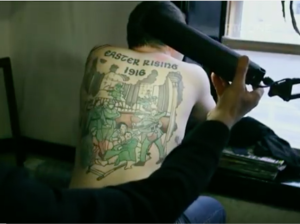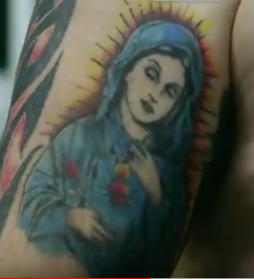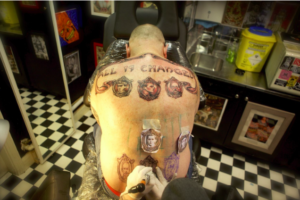Tattoos have long been regarded as an indicator of belonging to a particular ethnic or cultural sub-group. In her article “The Flesh Made Word: Tattoos, Transgression, and the Modified Body,” Christine Rosen theorizes that public opinion on tattoos has shifted in part to view tattoos as an expression of individuality, and not just a marker of deviance and/or belonging to a particular group.¹⁹ However, nationalist tattoos in present day Ireland simultaneously represent both systems: they function as an individual choice and indicator belonging to larger groups. The tattooed human body then, in this case, becomes a tool through which Irishmen can assert their loyalty to Ireland and more specified sub-groups of Irish culture.
The Easter Rising

The 2016 documentary “Baring Arms” explores the commemoration of the 1916 Easter Rising through individual tattoos of Rising leaders (including Padraig Pearse and James MacDonagh, amongst others) and places (such as the General Post Office). Often, these faces are accompanied with images symbolic of Catholicism such as Virgin Mary. Permanently tattooing imagery of the Rising on one’s body suggests to viewers that the person who received this tattoo is authentically “Irish.” In the video, one man even comments that his tattoo of the Rising includes an image of his grandfather, who was alleged to fight in the Rising.¹⁹ The imprinting of figures such as Pearse onto his skin marks himself as loyal to their cause and belonging to the “in-group” of Irishmen loyal to their nationalist predecessors.
In “Borderlines: Skin, Tattoos and Consumer Culture Theory,” Patterson and Shroeder analyze the cultural shift in Western societies regarding tattoos as a marking of deviance to an expression of individualism.¹⁸ They argue that as most forms of tattooing becomes less taboo and more socially acceptable, the human skin functions as a projection surface through which consumer culture can be applied and reinforced.* In the context of the Rising, commemorative tattoos such as the one in the image above become important because they function as consumer advertisement for loyalty to Ireland. It promotes a narrative about Ireland nationalism that takes pride in the Rising as a historic event that sparked the emergence of modern Irish nationalism and resist against Great Britain.

The commemorative tattoos here also raise interesting questions about the intersection of Catholicism with masculinity and Irish identity. In the clip above, the man in the video tattoos most of his torso, back and arms with figures of the 1916 Rising, and notably includes a tattoo of the Virgin Mary on his right upper arm. The inclusion of Mary in a set of tattoos designed to commemorative Irish heroes suggests that the true, or genuine, performance of Irish masculinity is one of both nationalism and Catholic faith. Here, the man asserts in the video asserts his masculinity through bodily commemoration: marking himself in the tradition of both Mary and the Rising leaders to pay homage to his Irish Catholicism.
Northern Ireland Tattoos
The marker of a person as belonging to particular ethnic or cultural sub-groups becomes particularly significant in Northern Ireland, where many neighborhoods contain a strained intersection of Catholic vs. Protestants, and Irish nationalists vs. Unionists, amongst others. Although their are many other markers of someone’s loyalty and ethnicity in Northern Ireland (accent, uniform, job status, phrasing of certain words, etc), tattoos serve as a way for Northern Irishmen to permanently indicate which community they identify with to others.

In the image above, the man in the photograph marks himself as an Ulster Unionist and a loyalist to Great Britain by inking the flags of the United Kingdom and Scotland, the British Crown, and the Red Hand of Ulster onto his body. These images, coupled with the Loyalist slogan “No Surrender,” connect the man with the tattoo to a series of powerful symbols and historical traditions that reinforce Britain’s present in Northern Ireland. Like the man with the Easter Rising tattoos, the Unionist tattoo uses the human body to place the man within the Loyalist tradition and reinforces his political and ethnic identity to others.


